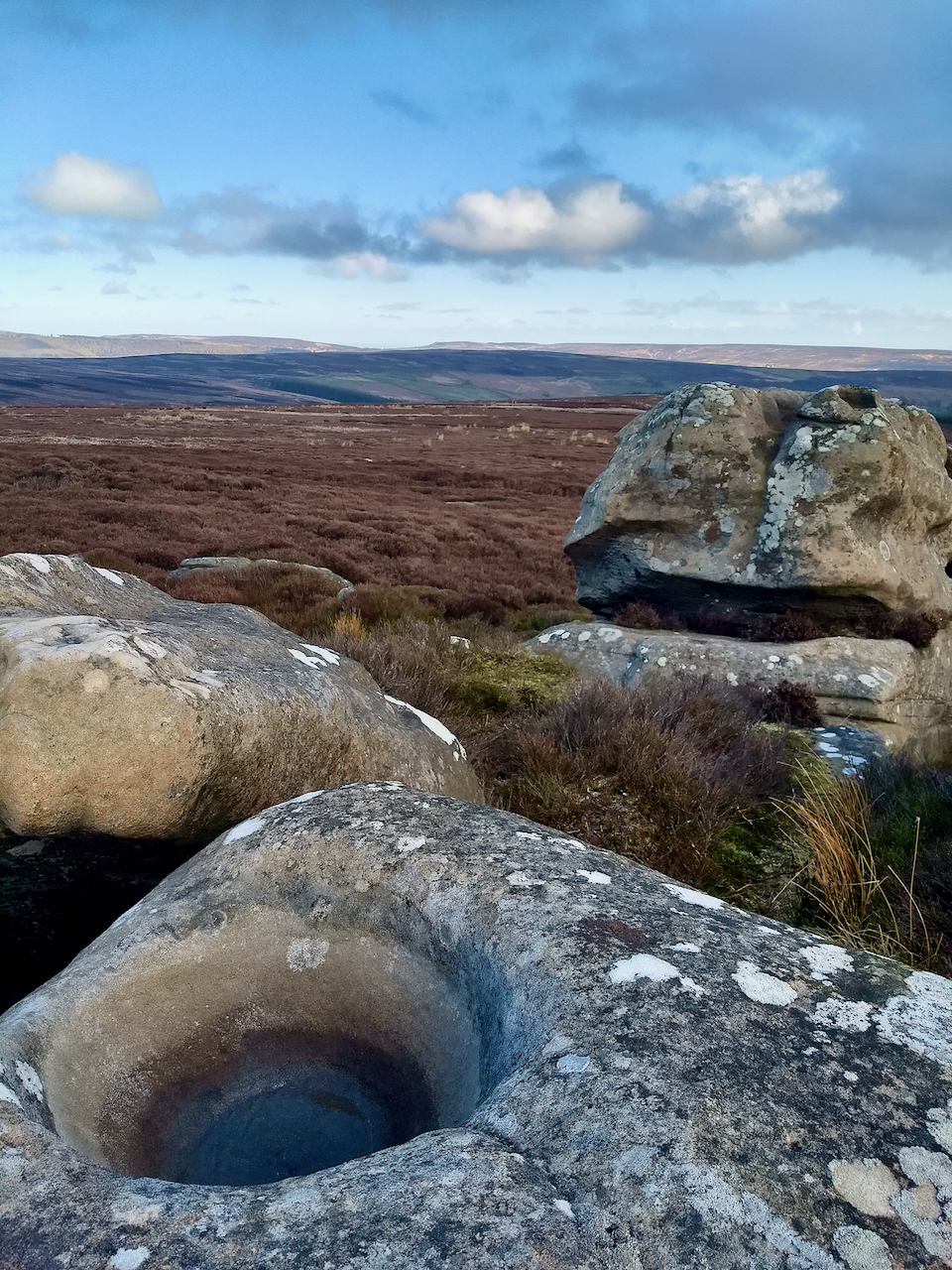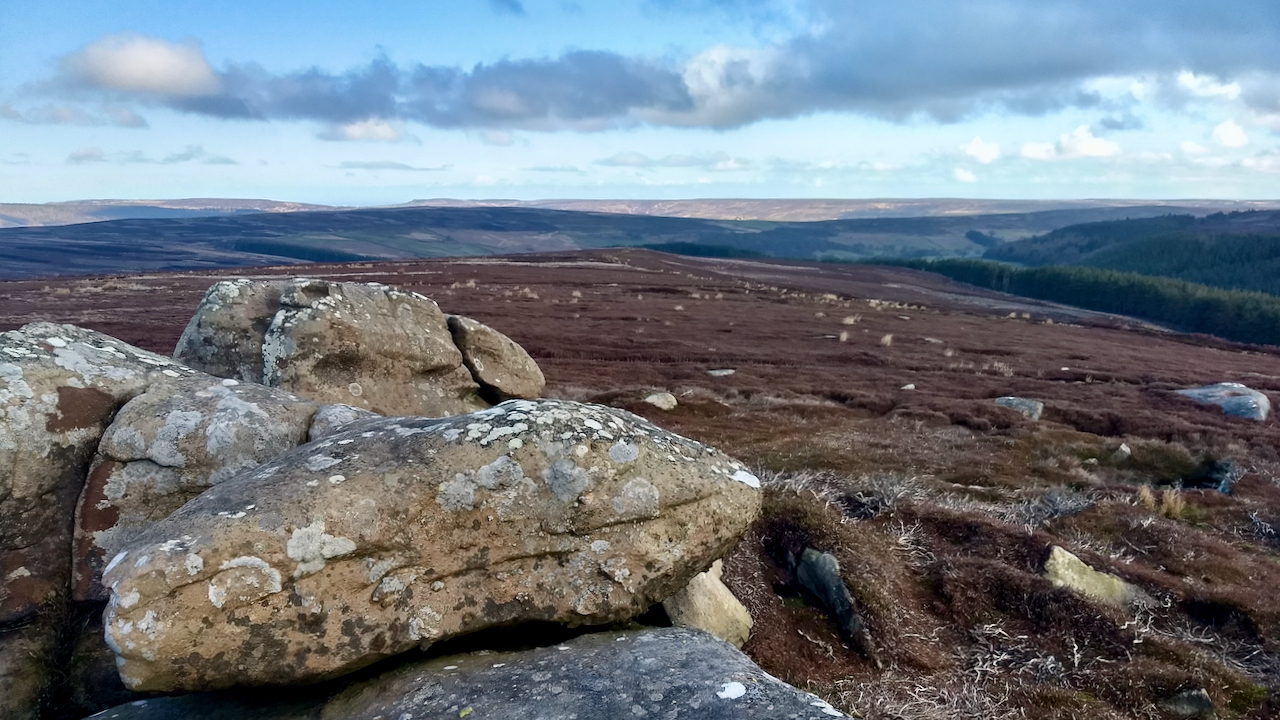A recent Facebook posting mentioned a “font” on the Cheese Stones on Ingleby Moor. I was intrigued. It’s been a few years since I visited this sandstone outcrop but I had never heard of a rock-font.
A little prompting revealed the information was found “on the web”, but the only reference I could find was a document scanned in on Google Books entitled “The Register Booke of Inglebye Iuxta Grenhow: As Much as is Exstant in the old booke. For Christnings, Weddings and Burials Since the yeare of Our Lord 1539” that was reprinted with an introduction by John Blackburne in 1889.
Dr. Geikie’s observation that the moorland “rocks are much decayed at the surface” is well borne out in this locality. But one instance of moorland weathering is deserving of a special description. On the tabular elevation of Middle Head — a tongue of moorland which divides the upper portion of Baisdale into two small branch dales drained by the confluent streams of Black Beck and Grain Beck — lies a group of large angular and tabular blocks of hard sandstone, the sole surviving remains of a stratum of Inferior Oolite which once existed there, and which at this point marks the boundary of the parish of Ingleby. Sufficiently striking in themselves from their size and number, they become much more remarkable on a nearer inspection; for, in addition to certain channelings and groovings , many of them bear impressed on their upper surfaces a series of what may be termed “Rock Fonts,” some of which are almost perfectly symmetrical in their proportions. The fonts vary in size from four or five inches to two or three feet in diameter and depth, and some of the blocks contain several of them. They are known as the Cheese Stones —a name which reminds one of the Cheese Wring, and the conferring of which upon these stones is probably due to the fact that large rectangular blocks of sandstone were commonly in use as weights in the local cheese presses, and not improbably many a block may have been brought from the group in question for such a purpose.

I find the Victorian language and detail fascinating. Mr.Blackburne continues with an explanation of the phenomena:
The origin of the basins is probably entirely due to the action of atmospheric weathering. The surfaces of the blocks on which they occur often slope at a greater or smaller angle, and if after a heavy rain you visit them while a strong wind is blowing, you will find the water which they contain circling round and round, bearing on its surface particles of any floating matter brought by the winds, and calculated in process of years or centuries to wear the depression larger and deeper, and to keep it in circular form. Or if your visit be after a period of drought, you may find the wind sweeping round within the fonts the minute flinty grains which have been abraded from their sides, and which tend to abrade those sides still further. When we add the action of frost, and the other causes which contribute to the weathering of rocks, we need not hesitate to admit that atmospheric agency is in itself enough to account for these striking depressions and their symmetrical shapes.
This is followed by a speculative discussion of the ritualistic use of these fonts:
Since we know that the rock fonts in high places generally accompanied the ancient and pretty universal worship of the heavenly host, we might be tempted to imagine that these blocks were the hill-altars of a community of Baal-worshippers, that in fact as the barrows in their immediate proximity represent the Church-yard, so these represent the Church of a primitive period. The Rev. Dr. J. C. Atkinson says “it is idle even to venture a surmise touching the moral or religious condition of these pre-historic races” who occupied Cleveland. But the numerous grave-mounds reveal to us the fact that neolithic man lived here. We have every reason to believe that it was his habit to raise dolmens in connection with his worship — such dolmens often being marked with rock-fonts in the cap-stone for the purpose of collecting the blood of victims, or into which to pour libations, or for some such purpose. Where, as in the case of the Cheese Stones, a natural solid altar existed, it obviated the necessity for raising a trilithon. If it be doubted whether these basins could have persisted since neolithic times, we must bear in mind that the atmospheric agencies to which we attribute the origin of the basins, would have availed equally to retain their form had they been originally artificial. While, therefore, We admit the probability that they were formed by the action of the weather, we see no reason for dogmatically asserting that they did not form a centre of worship for the men over whose remains were placed those mounds of earth which we now see near them. On the Greenhow Moor to the south, within the bounds of the parish, or at all events forming the boundary, is a solitary barrow of much larger dimensions than the three here, and near it a conspicuous natural altar with the remains of small rock-basins and grooves, upon which, on one side, a face has been carved in comparatively recent times. One large rounded block in the Cheese Stones group reposes upon a huge horizontal slab at a point so nearly under its centre of gravity that it forms a good specimen of a Rocking-stone.
It was all a good excuse for me to have a run over to the Cheese Stones this morning.
[Ref063]

Leave a Reply